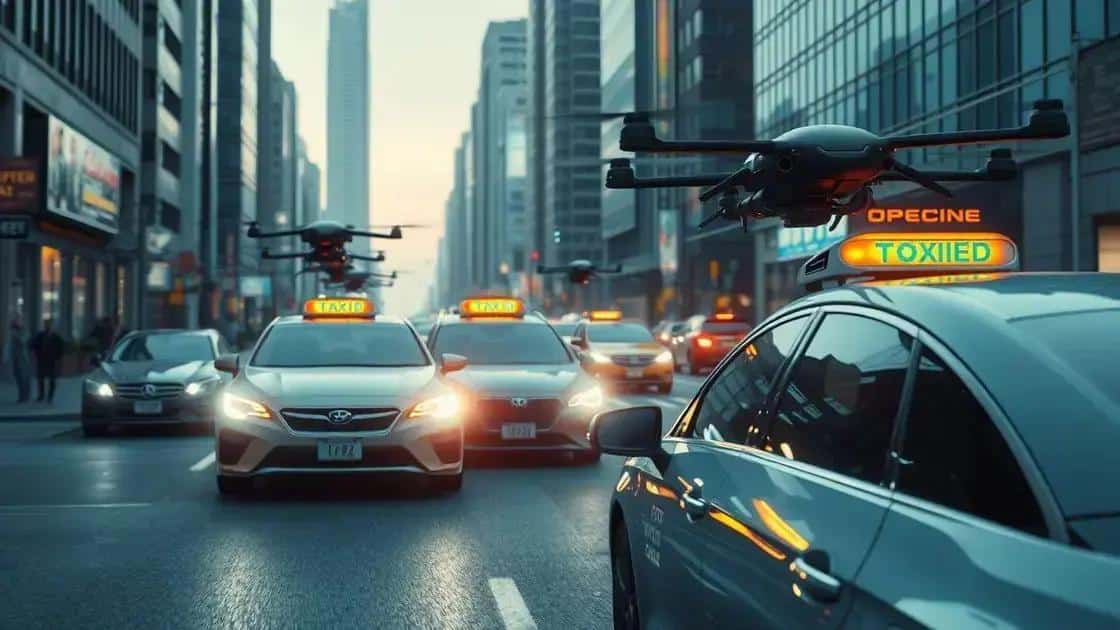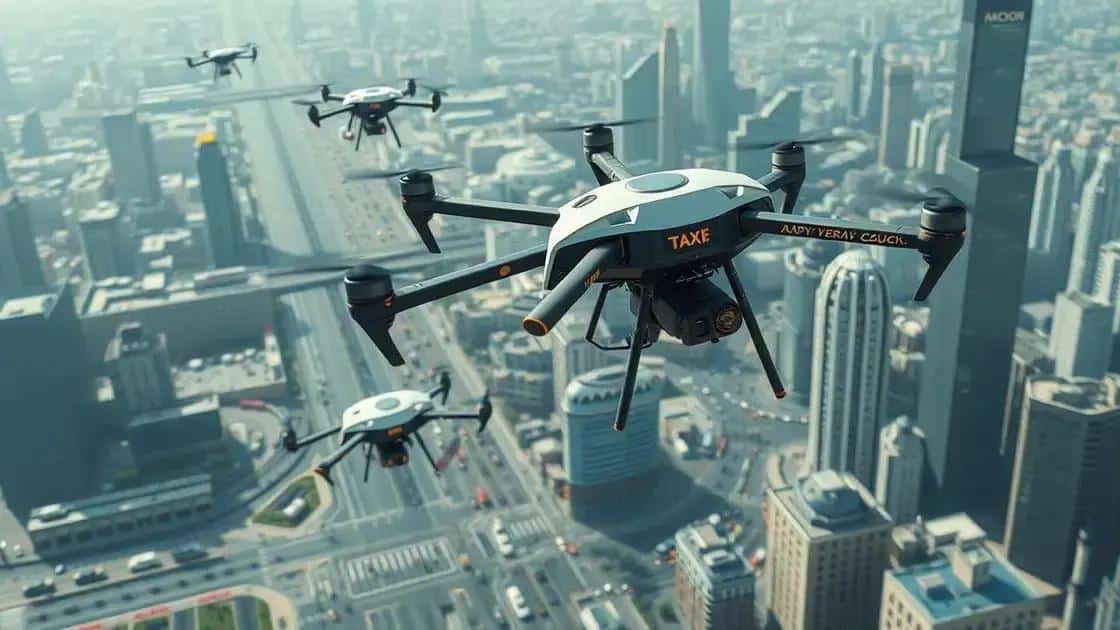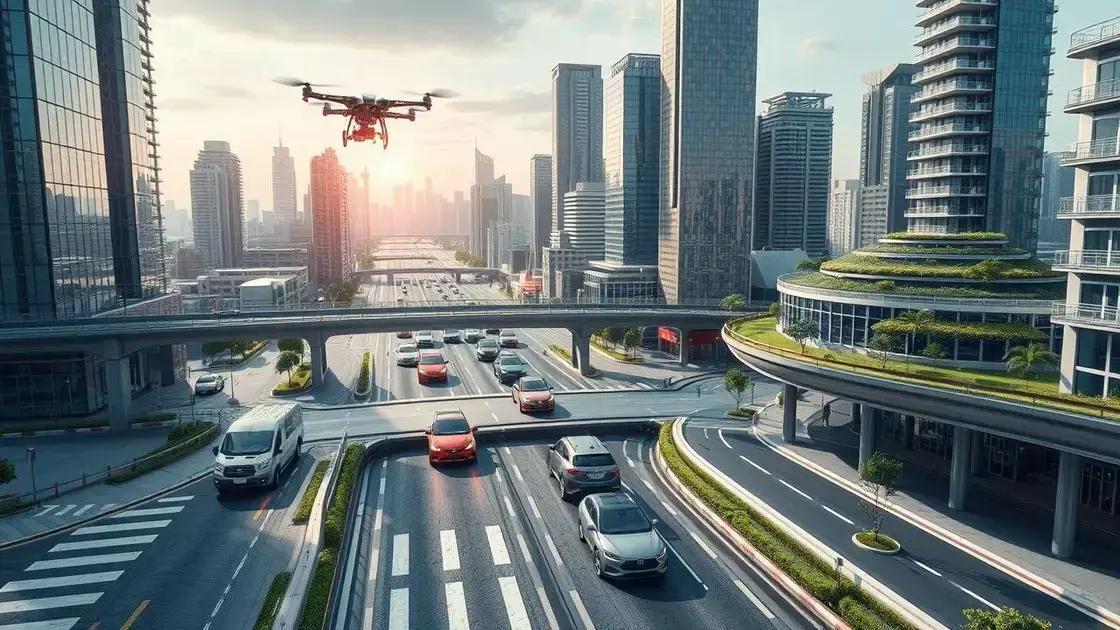Brain-assisted cars: taxi drones round out transportation concepts

Brain-assisted cars and taxi drones represent the forefront of transportation innovations, significantly enhancing safety, efficiency, and accessibility while promoting sustainable urban mobility.
Brain-assisted cars and taxi drones are more than just futuristic ideas; they could transform the way we think about travel. Have you ever imagined how these innovations might change your daily commute? Let’s dive in.
The rise of brain-assisted vehicles
The world is witnessing the rise of brain-assisted vehicles, changing the way we interact with technology and transportation. These vehicles are designed to enhance driving experiences by leveraging advanced neurotechnology.
How brain-assistance works
Brain-assisted vehicles utilize sensors that can detect brain signals. This technology enables drivers to communicate with their vehicles more intuitively. Imagine being able to steer, accelerate, or brake just by thinking about it!
Advantages of brain-assisted vehicles
- Increased safety through reduced human error
- Enhanced driving efficiency by anticipating driver needs
- Accessibility improvements for individuals with disabilities
As this technology evolves, it aims to create a seamless integration between human thought processes and vehicular control. The systems adapt to the driver’s habits and preferences, making the driving experience not only safe but also more enjoyable.
Imagine being able to change your music or send a text without taking your hands off the wheel. The potential applications are vast. In urban settings, these vehicles could help reduce traffic congestion by optimizing routes based on real-time cognitive feedback.
Challenges and considerations
Despite these benefits, there are challenges ahead. Issues regarding privacy, data security, and ethical concerns about how brain data could be used must be addressed. Ensuring the safety and reliability of this technology is crucial before widespread adoption.
Furthermore, public acceptance is essential for the future of brain-assisted vehicles. Manufacturers and policymakers need to communicate effectively about the safety and benefits of this innovation to foster trust among potential users.
Notably, the combination of brain-computer interfaces with driving technology is still in its infancy. Scientists and engineers are vigorously researching to refine these systems, ensuring they respond accurately to human thought.
Exploring the concept of taxi drones

Exploring the concept of taxi drones reveals a futuristic vision of urban transport. These flying vehicles aim to alleviate city traffic and provide quick, efficient travel. Imagine hailing a drone instead of a traditional taxi!
How taxi drones work
Taxi drones are designed to operate autonomously or with minimal human intervention. Equipped with advanced navigation systems, they can travel predefined routes, ensuring safety and efficiency. This allows for a streamlined approach to aerial mobility.
Benefits of taxi drones
- Significantly reduced travel times in congested urban areas
- Lower pollution levels as electric drones replace gas-powered transport
- Improved accessibility to remote areas
The appeal of taxi drones also lies in their potential to eliminate the frustration of gridlocked streets. Picture a world where you can bypass traffic and arrive at your destination in minutes. With technology rapidly evolving, this may soon be a reality.
However, as exciting as the concept is, there are practical considerations to explore. Infrastructure will need to evolve alongside these flying taxis. Designated landing zones and air traffic management systems will be essential to ensure smooth integration into our communities.
Challenges and future outlook
Despite their potential, there are challenges that need addressing. Regulatory frameworks must be established to maintain safety and security. Public perception also plays a role; educating the public about safety measures is crucial for widespread acceptance.
Tax drones could redefine how we view transportation, making air travel a common choice for daily commutes. As we continue to invest in technology and infrastructure, the dream of flying taxis might soon become an everyday reality.
Benefits of integrating advanced tech in transport
Integrating advanced technology in transport offers a range of benefits that can change the way we travel. From enhancing safety to improving efficiency, technology plays a vital role in shaping modern transport systems.
Improved safety measures
One of the most significant advantages of advanced tech in transport is the enhancement of safety. Features like automated braking systems and collision detection can help prevent accidents. These technologies allow vehicles to respond more quickly than human drivers.
Efficiency and convenience
- Real-time traffic updates help drivers choose the best routes.
- Smart traffic signals adjust based on traffic flow, reducing congestion.
- Ride-sharing apps allow for easier trip planning and coordination.
When technology is integrated into public transport, it can lead to more reliable services. For example, buses equipped with GPS systems can provide accurate arrival times, improving user experience. This technology not only makes commutes faster, but it also encourages public transport usage.
Furthermore, technological innovations like electric vehicles reduce carbon emissions and contribute to a cleaner environment. With the rise of autonomous vehicles, the potential for car-sharing systems increases, leading to fewer cars on the road.
Accessibility for all
Lastly, advanced transportation technologies enhance accessibility for individuals with disabilities or those living in remote areas. Features like automated doors and step-free access ensure that everyone can benefit from public transport.
By integrating technologies, we pave the way for a more sustainable and user-friendly transport system. The ongoing developments in this field suggest a promising future filled with exciting transportation innovations.
Future implications of these transportation innovations

The future implications of these transportation innovations are vast and exciting. As we embrace new technologies, they promise to reshape urban landscapes and enhance daily commuting experiences.
Urban planning and infrastructure changes
With the rise of autonomous vehicles and taxi drones, cities will need to adapt their infrastructure. New roads and takeoff zones for drones will be essential. This shift can lead to more green spaces as parking lots transform into parks.
Environmental impact
- Reduced emissions from electric vehicles will help combat climate change.
- Innovative transport solutions can decrease reliance on fossil fuels.
- Smart transportation systems can optimize traffic flow, reducing congestion and pollution.
As these innovations are adopted more widely, public transportation could see an increase in ridership. For instance, air taxis may offer quick transit options that cut travel time, making public transport more desirable than personal vehicles.
Additionally, the integration of technology in transport systems can lead to greater energy efficiency. Smart technologies can manage resource use better, ensuring sustainable practices are prioritized.
Social implications and accessibility
Transportation innovations will also improve social interaction. With greater accessibility, people from different backgrounds will meet and share experiences more easily. Inclusive transportation options will ensure everyone can travel without barriers.
In the future, we may also see an increased focus on personalized travel experiences. Innovations can allow for tailored transport solutions, meeting the unique needs of various populations.
FAQ – Frequently Asked Questions about Transportation Innovations
What are brain-assisted vehicles?
Brain-assisted vehicles are cars that utilize neurotechnology to enhance the driving experience, allowing drivers to control vehicle functions using brain signals.
How do taxi drones work?
Taxi drones operate autonomously, using advanced navigation systems to pick up passengers and follow designated flight paths, reducing travel time.
What benefits do transportation innovations offer?
These innovations can lead to improved safety, reduced emissions, enhanced efficiency, and greater accessibility for all types of users.
What is the future of transportation with these technologies?
The future includes smarter cities, cleaner air, and more integrated transport solutions that prioritize convenience and sustainability for everyone.






